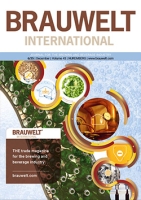Fine milling in combination with thinbed mash filters has been introduced into the brewing industry more than 20 years ago. Although clearest worts can be obtained at highest gravity, in combination with high extract yield and improved starch conversion, a majority of brewers still use the conventional coarse milling in combination with lautertuns. Brewers seem still afraid having a negative impact of fine milling on wort and beer quality especially with regard to over extraction of polyphenols, proteins and oxidative enzymes. A lack of detailed data comparing both wort production methods could be a reason. In this study, the faster wort filtration as well as higher extract yield has been confirmed when using fine milling and a thin bed filter..
As of mid-December 2012, there were 2,751 breweries with active operating permits in the United States – more than any other time in American history, according to the Beer Institute, an industry research group.
In the first part of this publication (see BRAUWELT International 6, 2012, pp. 354-358), tasting results for single-variety beers were described. These beers were hopped in the brewhouse, using both, traditional and new and promising varieties. In this second part, the results of tastings of dry hopped beers carried out globally are presented. These are based on more than 1500 individual evaluations of seven lager beers.
The Bühler Technology Group has agreed with the owner family of Maes SA to acquire 100 percent of the French company. Maes SA, which was set up in 1974 and is headquartered in the Alsatian town of Haguenau, France, specializes in products and services for the grain milling industry.
The following charts show the average relative differences between lead conductance value “LCV”
The European harvest of spring barley 2012/13 has been comfortable. Thanks to a vast acreage and a high yield the result of this year’s harvest is good, although regional quality problems could reduce the result. Nevertheless there will be a surplus in the EU 27. Depending on the quality it is expected to be between 0.75 and 1.4 Mio. t.
With the release of the „Special Flavor Hop“ cultivars Polaris, Mandarina Bavaria, Hallertau Blanc and Huell Melon, the search for new aromas has not yet been completed. During the presentation on 27/11/2012, the scientists at the hop research of the Bavarian State Research Center for Agriculture were able to present new breeding lines with mint-,apricot- and banana flavor, green apple aroma or intensive lovage flavor.
We carried out tests in our pilot plant to check the influence of hop product and contact time for dry hopping. The beer we used was a moderate pale ale with 5,6 % alcohol and with a bitterness of 32 IBU. For dry hopping we added the variety Hallertau Tradition in the form of leaf hops and pellets from the same processing order (see table 1). The beer was stored at 4°C for 18 days. Sampling was done prior to dry hopping and then after 4 and 8 hours and then again after 1, 5, 7, 11, 13 and 18 days according to the numbers 1 to 10 in both diagrams. ...
Castle Malting® (or Malterie du Château®
Effective January 1, 2013, the Bühler Technology Group will concentrate the core functions of its Malting market segment currently located at its two German sites in Braunschweig and Beilngries at the headquarters of its Grain Logistics business unit in Beilngries. This concentration at a single site is supposed to lead to a bundling of technological know-how, a fine-tuning of processes, and to a reduction in the number of interfaces. The overall aim of this decision is to strengthen the competitiveness of the Malting market segment in view of meeting future market challenges. All employees in Braunschweig affected by this change will be offered a new job in Beilngries.
As in previous years we would like to demonstrate how the contribution of hop oils to beer can vary from one crop year to another. We have chosen linalool as a representative hop aroma substance as it correlates well with the sensory impression of hoppy aroma in beer.


